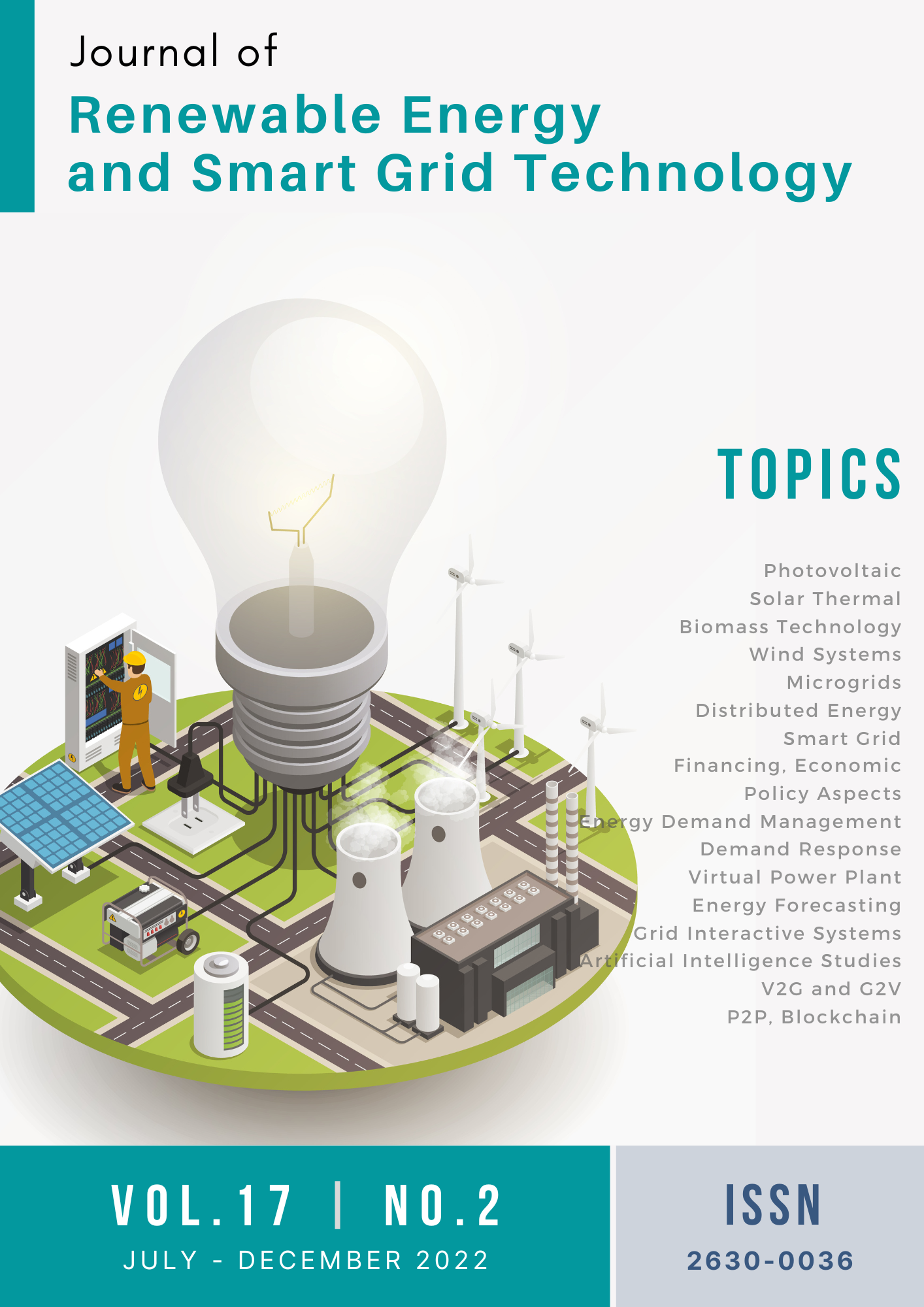A semi-empirical model for calculating spectral global solar irradiance under clear sky conditions in Thailand
Keywords:
global solar irradiance, spectrum, clear sky, model, thailandAbstract
This paper presents the development of a semi-empirical model for calculating spectral global solar irradiance in Thailand. The model expresses the spectral global solar irradiance as an empirical function of atmospheric constituents affecting radiation. To develop the model, global solar spectral irradiance was measured at Chiang Mai (18.78°N, 98.98°E), Ubon Ratchathani (15.25°N, 104.87°E), Nakhon Pathom (13.82°N, 100.04°E) and Songkhla (7.18°N, 100.60°E). Five years (2017-2021) of spectral data from these locations were collected and separated into two groups. The first group (2017-2020) was used for modeling while the second group (2021) was employed for model validation. The validation results revealed that the values of spectral global irradiance calculated from the model and those obtained from the measurements were in good agreement with the discrepancy in terms of mean bias difference and root mean square difference of 0.98% and 9.61%, respectively. These results imply that the developed model performs well in calculating spectral global solar irradiance.
References
Green, M. A. (1982). Solar Cells: Operating Principles, Technology and System Applications. New South Wales, Australia: University of New South Wales.
Duffie, J. A., Beckman, W. A. & Blair N. (2020). Solar Engineering of Thermal Processes, Photovoltaics and Wind (5th Edition). New York, United States: Wiley.
Mayer, B. & Kylling, A. (2005). Technical note: The libRadtran software package for radiative transfer calculations - description and examples of use. Atmospheric Chemistry and Physics, 5(7), 1855-1877.
Ricchiazzi, P., Yang, S., Gautier C., & Sowle D. (1998). SBDART: a research and teaching software tool for plane-parallel radiative transfer in the earth's atmosphere. Bulletin of the American Meteorological Society, 79(10), 2101-2114.
Kneizys, F. X., Shettle, E. P., Abreu, L. W., Chetwynd, J. H., Anderson, G. P., Gallery, W. O., Selby, J. E. A. & Clough, S. A. (1988). In Users Guide to Lowtran 7. MA, United States: Air Force Geophysics Laboratory.
Myers, R. D. (2013). Solar Radiation Practical Modeling for Renewable Energy Applications (1st Edition). Florida, United States: CRC Press.
Leckner, B. (1978). The spectral distribution of solar radiation at the earth’s surface. Solar Energy, 20(2), 143-150.
Brine, D. T. & Iqbal M. (1983). Solar spectral diffuse irradiance under cloudless skies. Solar Energy, 30(5), 447-453.
Bird, R. E. & Riodan C. (1986). Simple solar spectral model for direct and diffuse irradiance on horizontal and tilted planes at the Earth's surface for cloudless atmospheres. Journal of Climate and Applied Meteorology, 25(1), 87–97.
Gueymard, C. A. (2001). Parameterized transmittance model for direct beam and circumsolar spectral irradiance. Solar Energy, 71(5), 325–346.
Torres-Ramírez, M., Elizondo, D., García-Domingo, B., Nofuentes, G. & Talavera, D.L. (2015). Modelling the spectral irradiance distribution in sunny inland locations using an ANN-based methodology. Energy, 86, 323-334.
Rocco, J. D., Bourke, P. D., Patterson, C. B. & Kider, J. T. (2020). Real-time spectral radiance estimation of hemispherical clear skies with machine learned regression models. Solar Energy, 204, 48-63.
Gueymard, C. A. & Kocifaj, M. (2022). Clear-sky spectral radiance modeling under variable aerosol conditions. Renewable and Sustainable Energy Reviews, 168, 1-17.
Kittitanadet, P., Masiri, I. & Janjai, S. (2016, June 8-10). Comparison of direct normal irradiance models under clear sky condition at Nakhon Pathom, Conference on Energy Network of Thailand (E-NETT), Wangchan Riverview hotel, Phitsanulok, Thailand.
Jacovides, C. D., Kaskaoutis, D. G., Tymvios, F. S. & Asimakopoulos, D. N. (2004). Application of SPTRAL2 parametric model in estimating spectral solar irradiance over polluted Athens atmosphere. Renewable Energy, 29, 1109-1119.
Madkour, M. A., El-Metwally, M. & Hamed, A. B. (2006). Comparative study on different models for estimation of direct normal irradiance (DNI) over Egypt atmosphere. Renewable Energy, 31, 361-382.
Gueymard, C. A. (2008). Prediction and validation of cloudless shortwave solar spectra incident on horizontal, tilted, or tracking surfaces. Solar Energy, 82, 260-271.
Koussa, M., Saheb-Koussa, D. & Hadji, S. (2017). Experimental investigation of simple solar radiation spectral model prefermences under a Mediterranean Algerian’s climate. Energy, 120,751-773.
Iqbal, M. (1983). An introduction to solar radiation. New York, USA: Academic Press.
Gueymard, C. A. (1995). SMART2, A Simple Model of the Atmospheric Radiative Transfer of Sunshine: Algorithms and performance assessment. Florida, USA: University of Central Florida.
Kasten, F. (1966). A new table and approximation formula for the relative optial air mass. Archiv für Meteorologie, Geophysik und Bioklimatologie, Serie B, 14, 206-223.

Downloads
Published
How to Cite
Issue
Section
License
Copyright (c) 2022 School of Renewable Energy and Smart Grid Technology (SGtech)

This work is licensed under a Creative Commons Attribution-NonCommercial-NoDerivatives 4.0 International License.
All copyrights of the above manuscript, including rights to publish in any media, are transferred to the SGtech.
The authors retain the following rights;
1. All proprietary rights other than copyright.
2. Re-use of all or part of the above manuscript in their work.
3. Reproduction of the above manuscript for author’s personal use or for company/institution use provided that
(a) prior permission of SGtech is obtained,
(b) the source and SGtech copyright notice are indicated, and
(c) the copies are not offered for sale.








